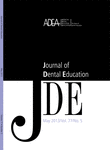- © 2004 American Dental Education Association
A Call for Increased Education in Genetics for Dental Health Professionals
- Francis Collins, M.D., Ph.D. and
- Lawrence Tabak, D.D.S., Ph.D.
+ Author Affiliations
- Direct correspondence and requests for reprints to Dr. Francis Collins, Director, National Human Genome Research Institute, National Institutes of Health, Bldg. 31, Room 4B09, 9000 Rockville Pike, Bethesda, MD 20892; 301-496-0844 phone; 301-402-0837 fax; francisc@mail.nih.gov.
- Received May 15, 2004.
- Accepted May 25, 2004.
Why genetics education for dental health professionals? Why now? Because education is about the future, not the past, and we are now entering the era in which genetics and genomics will play a vital role in both oral health research and dental practice.
Genetics is not just about rare disorders anymore, and it is no longer confined to the genetic specialist; it increasingly affects every facet of health care—including dental practice. Of course, dentists have long recognized patients that have a genetic contribution to a dental health problem. Some of these patients have physical malformations resulting from a hereditary condition (such as osteogenesis imperfecta with dentinogenesis imperfecta; cleft lip/cleft palate). Dental practitioners also commonly encounter hereditary conditions associated with abnormal tooth formation or periodontal disease.1 Other patients may have oral complications resulting from undiagnosed systemic health problems that genetic factors play an important role in causing, such as adult-onset diabetes.2
Dentists must be able to recognize indications of a hereditary component that may be causing these and many other oral pathologies. As advances in genomics add dramatically to the number of dental conditions whose genetic component is understood, the need for dental professionals to understand, recognize, and utilize genetics in their daily work grows commensurately. For example, individuals vary in their genetic predisposition and response to oral pathogens and other environmental factors. The complexity of these interacting variables is evident in recent literature about susceptibility to periodontitis.3 Patients may ask about using a currently marketed genetic susceptibility test to identify their risk for major periodontal disease. Being able to understand and discuss the value of such a genetic test for patients requires sufficient understanding of genomic information to assess the value of the test in individualizing patient care.4 Of course, genomic information is dynamic, not static, because investigators continue to assess host factors and organism characteristics to improve prevention, diagnosis, classification, and treatment options for oral conditions, such as periodontitis (www.nidcr.nih.gov/news/031292004.asp).
Genetic tests of the future will include measurement of other patient characteristics that influence dental care, such as response to medications. This is an emerging discipline known as pharmacogenomics. Generally effective therapies provide certain individuals insufficient relief from orofacial pain. The National Institute of Dental and Craniofacial Research currently supports pain research that utilizes genetic techniques to study variability and assess inherited individual differences to pharmacological and behavioral interventions (see www.nidcr.nih.gov/research/long_range_research_opps.asp). Assessment of pain response at the molecular level may provide improved options for future pain management, which is an example of pharmacogenomics being used to individualize patient care. Comprehension of the factors utilized to select personalized interventions necessitates a commitment to ongoing genetics education.
Exciting new technology based on the foundation of genetic research has the potential to create even more options for the dental professional to advance the oral health of the public. For example, salivary gland gene transfer (www.nidcr.nih.gov/news/03102004.asp), tissue engineering (www.nidcr.nih.gov/news/12012003.asp), the use of saliva as a diagnostic fluid (www.nidcr.nih.gov/research/cbi/atrp.asp), and use of primary teeth as a source of stem cells (www.nidcr.nih.gov/news/04122003.asp) are just a few of the scientific advances that need to be incorporated into the education provided for the next generation of dental professionals. The American Dental Association, in its Future of Dentistry report (2002), appropriately recognizes scientific and technology trends, including genomics, as a key component in potentially improving understanding of human health (www.ada.org/pro/resources/topics/futuredent/future_execsum.pdf).
Dentists and dental hygienists have a responsibility to integrate genetic information into their clinical practice as it becomes available. This is a challenge because most practicing oral health professionals have had little exposure to genetics in their training. As highlighted in the articles by Dudlicek et al.5 and Behnke and Hassell6 in this issue of the Journal of Dental Education, more emphasis on genetics education is needed in the dental curriculum. Focus group research with dental health professionals indicates that most do not think that genetics is relevant to dentistry today, but they recognize its great potential in the future.7 The importance of genetics in dentistry has been recognized by the National Coalition for Health Professional Education in Genetics (NCHPEG), an “organization of organizations” committed to a national effort to promote health professional education and access to information about advances in human genetics. This coalition has developed an educational site “Genetics, Disease, and Dentistry” to help dental health professionals incorporate genetic concepts into practice (www.nchpeg.org/dental/).
The future contribution of genetic discoveries to improving oral health will bring many opportunities as well as challenges. Genomic science is advancing knowledge rapidly, and dentistry must be ready to capitalize on these emerging opportunities (see www.nidcr.nih.gov/funding/training_expert_panel82002.asp). Translation of genomic research discoveries to improved clinical outcomes can only occur with an informed professional workforce.8 An informed dental professional can be an active contributor to the design of systems, tools, and resources that integrate genetics into clinical care. This contribution to quality care starts with the recognition of the importance of genetics education, beginning now.
Footnotes
-
Dr. Collins is Director, National Human Genome Research Institute, and Dr. Tabak is Director, National Institute of Dental and Craniofacial Research, both at the National Institutes of Health. Direct correspondence and requests for reprints to Dr. Francis Collins, Director, National Human Genome Research Institute, National Institutes of Health, Bldg. 31, Room 4B09, 9000 Rockville Pike, Bethesda, MD 20892; 301-496-0844 phone; 301-402-0837 fax; francisc@mail.nih.gov.



